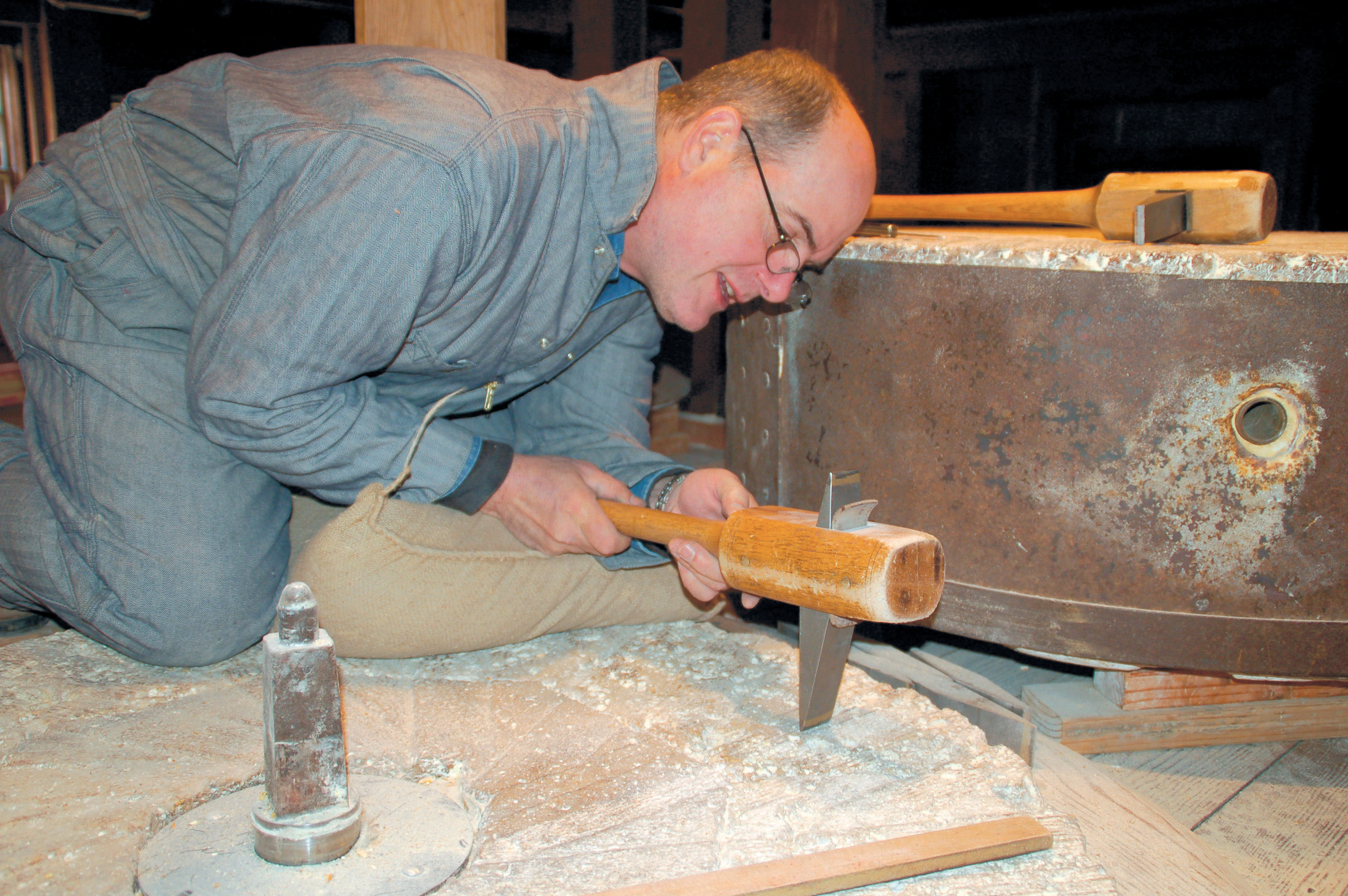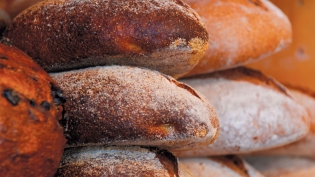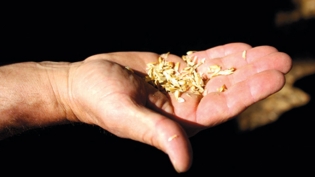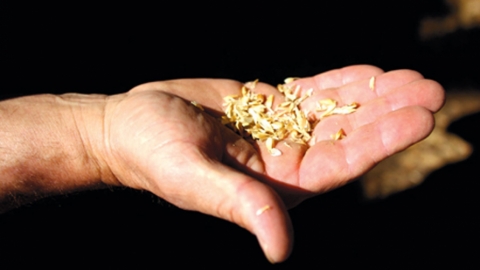Surfing Amber Waves of Grain, Part II: Rebirth of the Miller
“The mill is the altar upon which the grain sacrifices its life for us. We must mill it correctly so that the life force is milled into the flour.”
—Roger Jansen, millstone dresser and millwright“While bread rises we talk about traditions lost here, stone sharpening and machining...and about the growth of bread as proof that industry has not sterilized all life from this country.”
—Ben Gallagher, from his poem “On Hills Licked by Butter”
The trinity of farmer, miller and baker provides strength, sustenance and health to the heart of a food system. Absent from our local foodshed for over a century, the arts of growing, milling and creating food from local grains are being resurrected in our area through the work of passionate farmers, millers, bakers and community builders. In our Summer issue we examined the resurgence of local grains. Here, in Part II, we explore the processing of the local harvest and the role of the mill and the miller.
I started this journey last spring, standing on the edge of ankle-high grain fields at Front Porch Farm in Healdsburg with owner Peter Buckley and farm manager Matt Taylor. While admiring the young plants, Peter and Matt described their leap of faith in planting several heritage varieties of wheat for Community Grains, a Northern California producer of whole-grain flours, pastas and polenta that is working on a larger-scale to foster the infrastructure and community needed to bring grains from local growers to local consumers. Through Peter and Matt I met Doug Mosel and the North Coast Grain Growers that same week, unveiling for me the surging renaissance in the local grain community.
Now in late summer, Mosel graciously returns my call during a break from his combine work harvesting those now mature fields of grain at Front Porch Farm. I wanted to talk to him about the progress of efforts to build the greater infrastructure needed to process the boom in local grains being grown by farmers in our area. Mosel and other members of the North Coast Grain Growers have been instrumental in this work. Mosel’s own Mendocino Grain Project has the equipment and know-how required to harvest, clean and/or mill for smaller-scale grain farmers—hence his work at Front Porch Farm. These resources are critical to these growers, many of them diversified family farms, because, even if they have a mill nearby, most have minimum quantity thresholds for processing that smaller farms cannot meet.
Our Northern California milling resurgence is preceded by a colorful history of the art.
Building mills (done by people called “millwrights”), carving and caring for the millstones (carried out by “stone dressers”) and milling grains (the “millers”) were three different roles for centuries. Historically, the millwright was the mysterious engineer who guarded the secrets of which wood to use for varying functions, what designs worked best for different situations and the overall alchemy of what made a good mill. The mill- wright was considered strangely powerful and old tales say that the spit of a millwright can kill a toad. The stone dresser was a mysterious traveler going from mill to mill, his experience etched into his arms where tiny shards of iron had flown off his tools and embedded themselves under his skin. On being asked by a miller to “show his mettle,” he would roll up his sleeves and the tiny blue scars peppering his arms proved his experience.
Most surprising to me was the archetype of the miller as a greedy, dishonest man. According to master miller, mill- wright, millstone dresser and educator Theodore R. Hazen, “In Colonial America attitudes towards the miller began to change. Once, the miller was considered so dishonest that in England they weren’t allowed to own mills or set their own prices. They rented their mills from the landowner, either a lord or the king, and were employees at best. During Medieval times farmers had to take their grain to the lord or king’s mill and pay for the services with a sizeable portion of their grain.” Anyone found owning a hand quern, a simple device consisting of a pair of small stones first used in the Neolithic era to grind grains, risked heavy penalties and possible hanging. Yes, thank goodness the farmer had the lord or king to protect him from being taken advantage of by the “wicked” miller...
In Colonial America you continued to need a land grant from the king to build a mill, but once America became independent this feudal attitude and system was left behind. Our resistance to continuing a feudal system in our newly independent nation enabled us to grow deep roots as a culture that thrived on independence and freedom of choice. This stands us in good stead as we currently work to rebuild our local food systems and resist governmental agencies and other forces trying to inappropriately control our food choices in a manner that negates our food sovereignty in order to serve “the king”—aka agri-business giants.
Today’s independent milling community is still small and the millers, millwrights and millstone dressers who are involved with local and true whole-grain milling are people who, unlike their secretive European predecessors, are passionate about sharing their experience and knowledge with others and making sure that this rebirth takes a strong hold in local communities. One member of the milling intelligencia is Roger Jansen, the producer of Jansen Stone Mills, who has a lifetime of experience as a miller and millstone dresser. Jansen led a millstone-dressing workshop at Grind- stone Bakery in Rohnert Park last May that was co-hosted by the North Coast Grain Growers and Monica Spiller and the Whole Grain Connection. The hands-on workshop was for bakers and others who own or are planning to own their own mill. “It was a wonderful workshop and it means so much seeing all of this happen because I’m 80 years old and this is a dream of mine to pass on what I know. The women were particularly amazing with the stones. Learning how to dress the stones is not a big mystery and they really got into it,” Jansen reported when I spoke to him after the workshop. He hopes another local millstone-dressing workshop will be held next year.
Joe Vanderleit has been in the milling business for 40 years and is on the forefront of the growing movement to stop the degradation of grains caused by today’s widespread commercial milling processes. His company, Certified Foods, makes true intact whole-grain flours under the name Joseph’s Best, and is also a milling partner of Community Grains. Vanderleit has an amazing amount of experience and knowledge about milling and whole grains and is an enthusiastic teacher, not letting you skip key elements of the conversation. I particularly appreciated his important insights into the history and complexity of milling and whole grain. For example, he informed me that the word “flour” was originally a variant of the word “flower.” The spelling was changed to “flour” in the early 1800s to end confusion. “Flower, and then later ‘flour,’ originated from the old French ‘fleur,’ which literally meant ‘blossom’ and was also used to mean ‘the finest,’” Vanderleit explained. “The phrase ‘fleur de farine’ meant the finest part of the meal, achieved by the elimination of the coarse matter from the grain—the bran and the germ, which were thought to be dirty.” Little did they know! When you separate the bran [the outer covering of the seed, rich in fiber and fatty acids], the endosperm [the food for the seed’s embryo, which is all starch] and the germ [the plant embryo, rich in fatty acids, nutrients and protein] to make fine white flour, you end up with nothing but a nutrient-poor starch. Talking to him was an “aha” moment for me—this degradation issue had begun long before giant agri-business and the huge roller mills introduced in the late 1800s.
Using traditional stone mills alone doesn’t solve the degradation issue. It’s true that, if run correctly, they grind grain more slowly and produce less heat than the conventional roller mills and processes used by huge modern companies like General Mills and this does help keep more of the nutrients and flavors of the grain intact, but even the earliest of stone mills had the goal of separating out parts of the grain in order to create the finest, whitest flour, as Vanderleit had explained.
When I visited the recently renovated Bale Grist Mill in Napa, miller Jim Annis had demonstrated for me how, formerly, the ground grain would leave the wheel and then enter a system of screen-lined shakers that separated the grain, causing it to fall down into various bins placed below. The bins ranged from the fine (white pastry flour), to the fair, to middlings (also a term for broken grains) and finally to the brown bran. Traditionally, the bran was fed to livestock and the middlings were given to laborers. Thus the term “I’m fair to middling” came to be used outside the milling world to mean that you weren’t fine, but surviving. The separator system is no longer used at the Bale Grist Mill—they do only whole-grain milling.
So what does it mean when a label says flour or bread is “whole wheat” or “whole grain?”
Well, even if it’s organic, if it was produced by a conventional mill, chances are excellent that it does not mean the grain is really “intact.” The bran, germ and endosperm were all separated in the milling process, and the flour was then “reconstituted” by adding back in some of the separated bran and germ. But, of course, that is not the same -once the seed is separated you lose the antioxidant relationship of the parts and it starts to deteriorate. Once this bond is broken and the deterioration starts, it cannot be reversed. In short, the seed has everything it needs to create life in one tiny, complex package whose ingredients were meant to stay together. According to Joe Vanderleit, “During germination, the primary function of the starchy endosperm is to supply energy to the seedling prior to the development of roots. The bran and the germ serve many other functions, including signaling activation of biologic processes, preventing adverse oxidation and defense of the seedling against microorganisms.”
Popular myth has it that freshly milled whole grain goes rancid quickly and must be refrigerated or frozen. In actuality, the growers, bakers and millers that I’ve spoken to are finding that it lasts for many months if properly stored. This speaks to Vanderleit’s point about the seed having a built-in mechanism for protection against microorganisms and oxidation.
Loss of positive nutrients is also an issue with this separation. The differentiation in nutrient values between a reconstituted whole-wheat flour and an intact whole-wheat flour is staggering: some studies show over a 70% loss of vitamins B1, B2, B3, B6, E and minerals like iron, magnesium, phosphorus, potassium and zinc. These nutritional factors have begun to be recognized and studied by scientists and nutritionists who are exploring the recent explosion in wheat and gluten allergies and sensitivities. It is interesting to note that a rising number of people who were previously wheat- or gluten-intolerant report that they are able to enjoy freshly milled and intact organic whole-grain wheat products. I happen to be one of those people who, over time, began to have allergic reactions to anything containing more than a modicum of wheat and I have noted that I do not have these same reactions when I eat breads or pastas produced by friends or small bakeries that mill their own flour.
There are two schools of thought on how these widespread wheat and gluten sensitivities might be lessened, if not eliminated. One theory is that the more ancient grains are easier to digest than modern wheat. The second theory focuses on the processing, which seems to be the key for me personally to comfortably eat bread and pasta. So, with great personal as well as journalistic interest, I met with Mark Shigenaga, PhD, of Children’s Hospital Oakland Research Institute, whose research focuses on delineating the role of diet, and grains in particular, in triggering systemic inflammation which underpins so many chronic diseases. He is also part of a science committee working with Community Grains. It’s Shigenaga’s theory that the methods used to process refined, non-intact grain might cause a “sugar shock” reaction in the gut of those people affected. He and I chatted about my experiences while eating the pastries I had brought to our meeting, made by Craig Ponsford at his Ponsford’s Place Bakery and Innovation Center in San Rafael using Community Grains flour. Apparently many of Ponsford’s customers have stories like mine and are now able to have their cake and eat it, too. Look for more on this in Part III of this story in the Winter 2012 issue of Edible Marin & Wine Country.
Throughout my discussions with farmers, millers, bakers and even oven makers, it is clear that inspiration flows in all directions, creating a beautiful web of connection. Craig Ponsford says he had been a fan of Joe Vanderleit for over 25 years, watching Vanderleit mill and promote whole grains, before something finally clicked for Ponsford, whose illustrious career as an award-winning baker had always been based on white flour. “In my case the miller inspired the baker,” says Ponsford.
In Roger Jansen’s case, the baker inspired the miller. During a 1991 trip with his son Larry to visit world-renowned oven maker Alan Scott in Tomales, he tasted the Flemish Desem whole-grain bread that Scott and his family baked and decided to start making mills for bakeries and for the home baker. “The contribution that Alan made to our pursuits cannot be overestimated,” he told me. Larry Jansen now makes Flemish Desem bread at his Hearth and Stone Bakery and uses a mill he made with his father. Blessed is this trinity.
Part I of Surfing Amber Waves of Grain was published in the Summer 2012 issue of Edible Marin & Wine Country.









